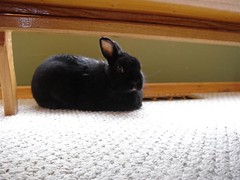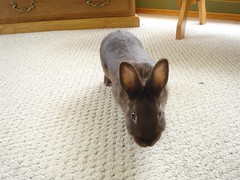
As I mentioned yesterday, today is Bunny Week. So let's talk about the science behind the rabbit!
Kingdom - Animalia - tells us it's an animal, not a plant
Phylum - Vertebrata - tells us it's a vertebrate
Class - Mammalia - a mammal
Order - Lagomorpha
Family - Leporidae
Genus
Species
 Different kinds of rabbits (from the hare to the cottontail) will have their own genus & species. The domesticated rabbit is considered to be Oryctolagus cuniculus.
Different kinds of rabbits (from the hare to the cottontail) will have their own genus & species. The domesticated rabbit is considered to be Oryctolagus cuniculus. The order lagomorpha contains only 2 families - the leporidae (hares & rabbits) & the ochotonidae (pikas - adorable little critters). A common misconception is that a rabbit is a rodent - not true. Rodents are in the order rodentia & are therefore about as distantly related to rabbits as we are (humans being in the order primates)! Of course, the "family tree" of all species is similar to a real tree & just as complicated. Not all the branches are going to be the same length. And so, 2 orders may be slightly closer together in relation than others (which is why there are more similarities between rodents & rabbits than between rabbits & humans).
 So what are the differences between a rabbit & a rodent? First off, a rabbit has 4 incisors (front teeth) instead of only two - 2 smaller incisors are placed behind the first 2. Similar to rodents though, their incisors grow throughout their lifetime - so they gnaw on things to keep them filed. Rabbits are also herbivores whereas rodents will forage for meat as well as vegetation. Lastly, there are differences in the male anatomy I won't get into.
So what are the differences between a rabbit & a rodent? First off, a rabbit has 4 incisors (front teeth) instead of only two - 2 smaller incisors are placed behind the first 2. Similar to rodents though, their incisors grow throughout their lifetime - so they gnaw on things to keep them filed. Rabbits are also herbivores whereas rodents will forage for meat as well as vegetation. Lastly, there are differences in the male anatomy I won't get into.What about the difference between a rabbit & a hare (AKA jackrabbit)? First, hares bear their young above ground instead of in burrows - so they've adapted to this more risky lifestyle. They are born precocial - with fur & open eyes, unlike rabbits. They run extremely fast & have a leaner body to go with it. Most noticeable is the longer, more prominent ears of a hare.
 You can tell rabbits have evolved as prey by their body shape - large hind legs to give them a rapid burst & erratic leaps to evade predators. Large eyes on the sides of their head for a more panoramic view. The large ears are thought to be an adaptation as well, to hear better I suppose - though the ears certainly provide some means of thermoregulation as well (particularly in the desert hare, where blood can cool off in the thin, long expanse of ear). And - you may have heard this one before - rabbits will eat some of their own poop ... in order to extract as many nutrients as they can from the tough, nutrient-poor grasses they eat. Of course, this is less true for a spoiled, fattened, house bunny.
You can tell rabbits have evolved as prey by their body shape - large hind legs to give them a rapid burst & erratic leaps to evade predators. Large eyes on the sides of their head for a more panoramic view. The large ears are thought to be an adaptation as well, to hear better I suppose - though the ears certainly provide some means of thermoregulation as well (particularly in the desert hare, where blood can cool off in the thin, long expanse of ear). And - you may have heard this one before - rabbits will eat some of their own poop ... in order to extract as many nutrients as they can from the tough, nutrient-poor grasses they eat. Of course, this is less true for a spoiled, fattened, house bunny.
And now it's time for a Public Service Announcement. While I'm the first to rave on what a wonderful pet a rabbit makes, they are NOT an ideal Easter present for a child. Rabbits must be taken with the same seriousness as a cat or dog - they live for just as long (well over 10 years if treated properly) & require the same amount of attention & care. Many pet store varieties are small - but some are not! The cute little baby bunny you got at Easter will soon be the size of a common house cat. So beware! Do your research before getting one of these magnificent animals!

1 comment:
Definitely NOT a starter pet! They need lots of time, lost of space, lots of patience! Kind of like horses.
Post a Comment